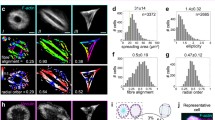Summary
Thrombospondins are a rapidly growing family of adhesive proteins that have diverse activities to modulate cellular growth, motility, and gene expression. Thrombospondin-1 (TSP) was the first identified member of this family and is the major form of thrombospondin in human platelets. A method is described to prepare TSP from human platelets in biologically active form with minimal degradation or contamination with other platelet proteins.
Similar content being viewed by others
References
Adams J, Lawler J (1993). The thrombospondin family. Curr Biol 3: 188–190.
Anstall HS, Urie PM (1986). A manual of hemotherapy. New York: John Wiley and Sons, pp 82–89.
Bornstein P (1992). Thrombospondins: Structure and regulation of expression. FASEB J 6: 3290–3299.
Clezardin P, McGregor JL, Manach M, Robert F, Dechvanne M, Clemetson KJ (1984). Isolation of thrombospondin released from thrombin stimulated human platelets by fast protein liquid chromatography on an ion exchange Mono Q column. J Chromatogr 296: 249–256.
Florence TM (1980). Degradation of protein disulfide bonds in dilute alkali. Biochem J 189: 507–520.
Lawler J, Simons ER (1983). Cooperative binding of calcium to thrombospondin. J Biol Chem 258: 12098–12101.
Lawler JW, Slayter HS, Coligan JE (1978). Isolation and characterization of a high molecular weight glycoprotein from human blood platelets. J Biol Chem 253: 8609–8616.
Murphy-Ullrich JE, Schultz-Cherry S, Höök M (1992). Transforming growth factor-β complexes with thrombospondin. Mol Biol Cell 3: 181–188.
Roberts DD, Haverstick DM, Dixit VM, Frazier WA, Santoro SA, Ginsburg V (1985). The platelet glycoprotein thrombospondin binds specifically to sulfatides. J Biol Chem 260: 9405–9411.
Santoro SA, Frazier WA (1987). Isolation and characterization of thrombospondin. Meth Enzymol 144: 438–446.
Sun X, Mosher DF (1990). Contamination of thrombospondin with vitronectin. Blood 76: 1666–1668.
Sun X, Skorstengaard K, Mosher DF (1992). Disulfides modulate RGD-inhibitable cell adhesive activity of thrombospondin. J Cell Biol 118: 693–701.
Speziale MV, Detwiler TC (1990). Free thiols of platelet thrombospondin: Evidence for disulfide isomerization. J Biol Chem 265: 17859–17867.
Tuszynski GP, Srivastava S, Switalska HI, Holt JC, Cierniewski CS, Niewiarowski S (1985). The interaction of human platelet thrombospondin with fibrinogen: Thrombospondin purification and specificity of interaction. J Biol Chem 260: 12240–12245.
Vogel T, Blake DA, Whikehart DR, Guo N-H, Zabrenetzky VS, Roberts DD (1993). Specific simple sugars promote chemotaxis and chemokinesis of corneal endothelial cells. J Cell Physiol 157: 359–366.
Vuillard L, Clezardin P, Miller A (1991). Models of human platelet thrombospondin in solution: A dynamic light scattering study. Biochem J 275: 263–266.
Author information
Authors and Affiliations
Corresponding author
Rights and permissions
About this article
Cite this article
Roberts, D.D., Cashel, J. & Guo, Nh. Purification of thrombospondin from human platelets. Journal of Tissue Culture Methods 16, 217–222 (1994). https://doi.org/10.1007/BF01540654
Issue Date:
DOI: https://doi.org/10.1007/BF01540654




